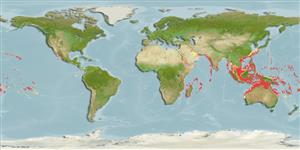Common names from other countries
Environment: milieu / Klimaatzone / Diepte / distribution range
Ecologie
marien; brak water rifbewoner; diepte 3 - 158 m (Ref. 27665). Tropical; 32°N - 28°S
Indo-Pacific: Red Sea south to Algoa Bay, South Africa (Ref. 4329) and east to the Line, Marquesan, and Pitcairn islands, north to southern Japan and the Hawaiian Islands, south to New Zealand (Ref. 8879) and Rapa.
Grootte / Gewicht / Leeftijd
Maturiteit: Lm ? range ? - ? cm
Max length : 15.5 cm TL mannelijk / geslacht onbekend; (Ref. 90102)
Dorsale stekels (totaal) : 8; Dorsale zachte stralen (totaal) : 9; Anale stekels: 2; Anale zachte stralen: 8. Tan to light red brown in color, dusky scale margins; a brown mid-lateral stripe from tip of snout, through eye to upper caudal base (stripe may fade on peduncle); black spot at base of caudal fin (Ref. 2334, 4329). Further characterized by relatively broad midlateral dark stripe; yellow anterior margin on dorsal fin; green to blue iridescent shades on body when viewed with light at night; juvenile with yellowish head and belly; greatest depth of body 2.5-3.3 in SL (Ref. 90102).
Body shape (shape guide): short and / or deep; Cross section: compressed.
Occurs in clear water lagoon patch reefs and seaward reefs from the lower surge zone to a depth of 45 m (Ref. 1602). Benthopelagic (Ref. 58302). Solitary (Ref. 93839). Feeds at night on small benthic and free-swimming crustaceans (Ref. 1602).
Levenscyclus en paargedrag
Maturiteit | Voortplanting | Paaien | Eieren | Fecunditeit | Larven
Mouthbrooders (Ref. 240). Distinct pairing during courtship and spawning (Ref. 205).
Myers, R.F., 1991. Micronesian reef fishes. Second Ed. Coral Graphics, Barrigada, Guam. 298 p. (Ref. 1602)
Status op de Rode Lijst van het IUCN (Ref. 130435: Version 2025-1)
Gevaar voor de mens
Harmless
Gebruik door de mens
Visserij: commercieel; Aquarium: Commercieel
Tools
Speciale rapporten
Download XML
Internetbronnen
Estimates based on models
Preferred temperature (Ref.
123201): 23.9 - 28.9, mean 27.5 °C (based on 1254 cells).
Fylogenetische diversiteitsindex (Ref.
82804): PD
50 = 0.5312 [Uniqueness, from 0.5 = low to 2.0 = high].
Bayesian length-weight: a=0.01259 (0.00802 - 0.01977), b=3.14 (3.01 - 3.27), in cm total length, based on LWR estimates for this species & (Sub)family-body (Ref.
93245).
Trofisch niveau (Ref.
69278): 3.5 ±0.0 se; based on diet studies.
Weerstandsvermogen (Ref.
120179): Hoog, minimale populatieverdubbelingstijd minder dan 15 maanden (Preliminary K or Fecundity.).
Fishing Vulnerability (Ref.
59153): Low vulnerability (10 of 100).
🛈
Nutrients (Ref.
124155): Calcium = 90.3 [44.4, 154.1] mg/100g; Iron = 0.753 [0.439, 1.305] mg/100g; Protein = 18.9 [17.7, 20.0] %; Omega3 = 0.157 [0.090, 0.276] g/100g; Selenium = 38.9 [19.3, 77.7] μg/100g; VitaminA = 53.3 [13.9, 199.5] μg/100g; Zinc = 1.51 [1.01, 2.19] mg/100g (wet weight);
